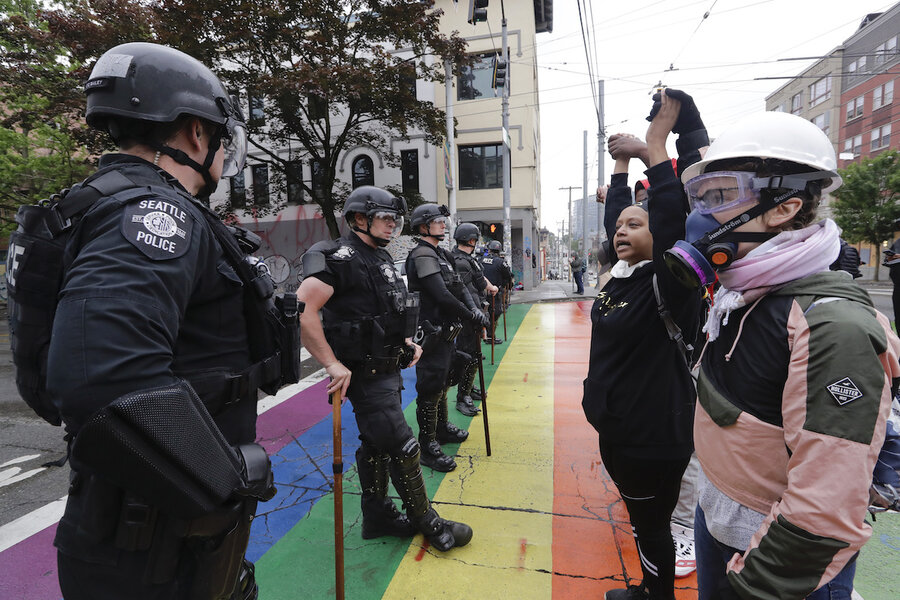Seattle PD clears ‘occupied’ zone, arrests dozens of protesters
Loading...
| Seattle
Wearing helmets and wielding batons and rifles, Seattle police turned out in force at dawn on Wednesday in the city’s “occupied” protest zone after the mayor ordered it cleared following two recent fatal shootings.
Officers stood shoulder-to-shoulder on several streets while others created a makeshift fence with their bicycles, using it to push dozens of protesters back away from the center of the “Capitol Hill Occupied Protest” zone just east of downtown. The group had occupied several blocks around a park for about two weeks after police abandoned a precinct station following standoffs and clashes that were part of the nationwide unrest over the killing of George Floyd in Minneapolis.
As residents in the neighborhood watched from balconies, police cleared out the protesters’ tents from the park and made sure no one was left in the park’s bathrooms.
More than three dozen people were arrested, charged with failure to disperse, obstruction, assault, and unlawful weapon possession.
“Our job is to support peaceful demonstration but what has happened on these streets over the last two weeks is lawless and it’s brutal and bottom line it is simply unacceptable,” Police Chief Carmen Best said.
One protest organizer, Derrek Allen Jones II, said some demonstrators attempted to stay but were surprised by the early intervention by officers who were “trampling everything ... in sight, flipping tables.”
“People were trying to hold their ground but you could see the cops literally storm through people’s beds while they were sleeping. And literally say ‘If you don’t get out, we will force you out or arrest you,’” he said.
One man dressed in black was peacefully led away in handcuffs and other demonstrators sat on the wet ground until their small group was handcuffed and detained.
Police also tore down fences that protesters had erected around their tents and used batons to poke inside bushes, apparently looking for people who might be hiding. One officer took down a sign saying “We are not leaving until our demands are met: 1. Defund SPD by 50% now. 2. Fund Black Communities. 3. Free all protesters.”
After police evicted the protesters, heavy equipment was used to remove concrete barriers and cart away debris from the encampments while officers strung yellow caution tape from tree to tree warning people not to reenter.
’I was just stunned by the amount of graffiti, garbage, and property destruction,” Ms. Best said after she walked around the area.
“The recent public safety threats have been well documented,” Mayor Jenny Durkan said at a news conference Wednesday afternoon. ”These acts of gun violence resulted in the tragic deaths of two teenagers, with multiple others seriously wounded. Despite continued efforts to deescalate and bring community together, this violence demanded action.”
Ms. Durkan also said while she supported the police in making arrests Wednesday, she doesn’t think many of those arrested for misdemeanors should be prosecuted. She also said she was committed to work that would dismantle systemic racism and build true community safety.
“Events in the Capitol Hill Organized Protest zone this morning, while necessary, should not diminish the cause of racial justice,” Gov. Jay Inslee said in an emailed statement.
Ms. Best said in addition to the fatal shootings, robberies, assaults, violence, and property crimes have occurred in the area in the last few weeks. She said she wanted police to move back into the precinct so officers could better respond to needs in the area. Protesters have said they should not be blamed for the violence in the area.
There had been mounting calls by critics, including President Donald Trump, to remove protesters. A group of local business owners sued the city, claiming that officials abandoned the area and made it impossible to run businesses because there was no police or fire protection.
U.S. Attorney General William Barr praised Ms. Best for what he called “her courage and leadership in restoring the rule of law in Seattle.”
“Chief Best has rightly committed to continue the substantive discussion while ending the violence, which threatens innocent people and undermines the very rule-of-law principles that the protesters profess to defend,” he said in a statement.
Seattle Black Collective Voice, which was formed by people in the protest zone, said previously that their work would continue even if they were forced out of that area. On Wednesday afternoon the group said via Twitter, “We don’t end with CHOP.”
This story was reported by The Associated Press. AP video journalist Aron Ranen in Seattle and writer Rachel La Corte in Olympia, Washington, contributed to this report.
Editor’s note: As a public service, the Monitor has removed the paywall for all our coronavirus coverage. It’s free.







